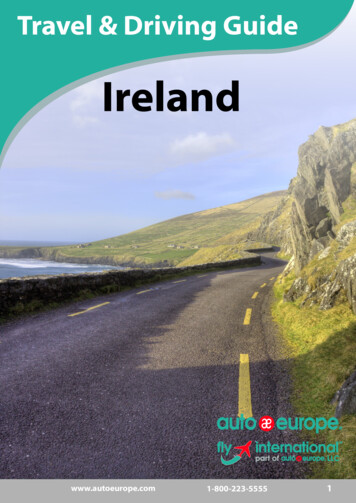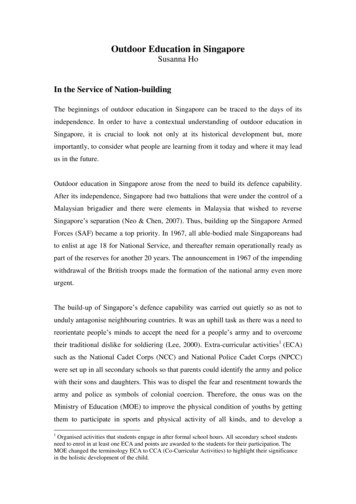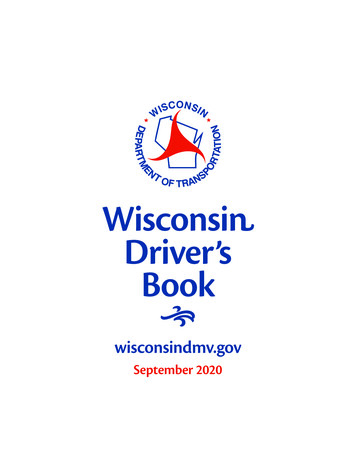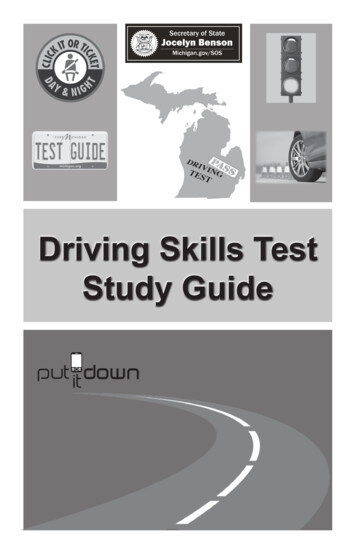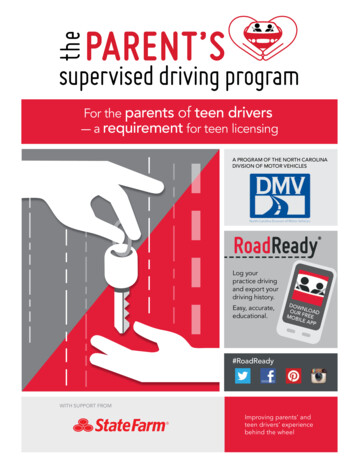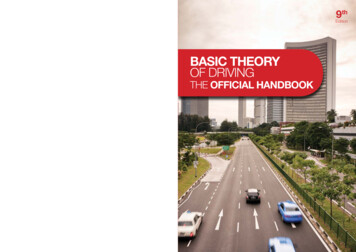
Transcription
th9EditionBASIC theoryof drivingThe Official HandbookPublished online by Traffic Police
BASIC THEORYOF DRIVINGTHE OFFICIAL HANDBOOK9th EditionCONTENTSBasic Theory of Driving(Ninth Edition) is publishedby Singapore Traffic Police.No part of this publicationmay be reproduced, stored in aretrieval system, or transmittedin any form or by anymeans, electronic, mechanical,photocopying, recording orotherwise, without the priorpermission of the publisher:Singapore Traffic Police10 Ubi Avenue 3Singapore 408865T (65) 6547 0000F (65) 6547 4900Published online byTraffic PolicePublished on 01.07.2017Note: The information containedin this handbook is accurateat the time of publication.Candidates are advised to log into the TP website at http://www.police.gov.sg & LTA website athttp://www.lta.gov.sg for thelatest updates.PART IDRIVING LICENCESIntroductionWhat Is A Driving Licence?Fitness To DriveClasses Of Driving LicencesTest Of Competence To DriveProvisional Driving Licence (PDL)Validity Of Driving Licence‘NEW’ DriversDriver Improvement Points System (DIPS)Medical ExaminationOnline Portals4444567781212PART IISIGNS AND SIGNALSMandatory SignsProhibitory SignsWarning SignsRegulatory SignsInformation SignsPedestrian Crossing SignsTraffic Signs For TunnelsSigns For Pedal-CyclesDirectional SignsExpressway Monitoring And Advisory System (EMAS)13151823252829303133BASIC THEORY OF DRIVING 1
CONTENTSEMAS SignsParking in URA/HDB Car ParksFacility SignsVehicle MarkingsCommon Road MarkingsDirection ArrowsMerging Arrow MarkingsSignals (Traffic Lights)Signals (On The Road)Signals Given By A Police OfficerHand Signals3537414142505051535456PART IIITRAFFIC RULES AND REGULATIONSThe Keep-Left RuleLane DisciplineOvertakingRoad-HoggingSpeed LimitsThe ‘Give Way’ Rule At Road JunctionsRoundaboutsYellow-Box JunctionsU-TurnsStopping And ParkingSeat BeltsLightsAlcoholLight Goods VehiclesHeight LimitsUse Of Mobile Telephone While Driving57575860606063646666686869707071PART IVCODE OF CONDUCT ON THE ROADMoving OffMirrors And SignalsDriving AlongTailgatingSafe Following DistanceThe ‘Two-Second’ RuleStopping DistanceReversing2 BASIC THEORY OF DRIVING7272727273737474
CONTENTSSafety Of PedestriansEmergency VehiclesGeneral Safe DrivingSafe Driving Technique (Defensive Driving Technique)Stopping And Moving Off At Traffic Light JunctionsRoadworthiness757576798687PART VPARTS AND CONTROLS OF A CARFront View/Rear ViewThe Instrument Panel (Dashboard)Names Of Various Driving Controls888989PART VIWORK ZONESRoad Users At Work ZonesWork Zone Signs9090PART VIIDRIVING IN SCHOOL ZONESSchool Zone SafetyTraffic Safety MeasuresDriving In School Zones929292PART VIIIDRIVING IN TUNNELSDaily Driving RulesLane Use And Variable Message Signs (LUS)Emergency FacilitiesEmergency/Incident Procedures93949596PART IXSECURITY MEASURES TO PREVENT THEFTOF/ FROM MOTOR PART XKEY POINTS OF THE MOTORCLAIMS FRAMEWORK (MCF)100BASIC THEORY OF DRIVING 3
PART IDRIVING LICENCESINTRODUCTIONThe “Basic Theory of Driving” handbook is essential reading for all road users in Singapore,which comprise the pedestrians, cyclists, motorcyclists and drivers. It covers The HighwayCode, which includes the traffic rules, traffic regulations, traffic signs and signals, and it aimsto educate and promote road safety for the road users. Many of the rules and regulationsin the Code are legal requirements, and if you disobey them, you are committing a trafficoffence. You may be fined and given demerit points on your driving licence, which may leadto suspension or revocation of your driving licence, or you may be disqualified by the Courtsfrom driving. Knowing and applying the traffic rules and regulations in The Highway Codecould significantly help to reduce road accidents, casualties and fatalities on our roads.WHAT IS A DRIVING LICENCE?1A driving licence is a legal document issued by the Traffic Police under the Road TrafficAct, which identifies the licensee, sets out the class(es) of vehicle(s) which he/she maylegally drive and states such restrictions or conditions as may apply as well as theperiod for which the licence is valid, where applicable.FITNESS TO DRIVE2In order to qualify for a driving licence to drive or ride a motor vehicle on the roads inSingapore, an applicant:(a) Must be at least 18 years old;(b) Must have passed the test of competence to drive;(c) Must not be suffering from mental disorder;(d) Must not be suffering from epilepsy;(e) Must not be liable to sudden attacks of disabling giddiness or fainting;(f) Must be able to read at a distance of 25 metres (with the aid of glasses, if worn) aseries of 6 letters and figures in white on a black background of the same size andarrangement as those prescribed for the identification mark of a motor vehicle; and(g) Must be able to distinguish the colours red, amber and green from a distance of25 metres.CLASSES OF DRIVING LICENCES3The following table is a list of classes of driving licence granted by the Traffic Police underthe law.Class 1DESCRIPTIONELIGIBILITYInvalid carriage of unladen weight notexceeding 250 kg and which are speciallydesigned and constructed, and not merelyadapted, for the use of persons sufferingfrom some physical defect or disabilityand are used solely by those persons.Invalids or those sufferingfrom some physical defector disability who are 18 yearsold and above.4 BASIC THEORY OF DRIVING
PART IDRIVING LICENCESClasses Of Driving Licences /Test Of Competence To DriveClass 2BMotor cycles with an engine capacity notexceeding 200 c.c., or motor cycles which arepropelled by electric motors and registered asmotorcycles.Class 2AMotor cycles with an engine capacity between 201c.c and 400 c.c.Be in possession of a class 2BQualified Licence for at least one year.Class 2Motor cycle with an engine capacity exceeding400 c.c.Be in possession of a class 2AQualified Licence for at least one year.Class 3Motor cars of an unladen weight not exceeding3000 kg with not more than 7 passengers,exclusive of the driver; and motor tractors /vehicles of unladen weight not exceeding 2500 kg.Class 3AMotor cars without clutch pedals (auto) of anunladen weight not exceeding 3000 kg with notmore than 7 passengers, exclusive of the driver;and motor tractors / vehicles without clutch pedalsof unladen weight not exceeding 2500 kg.Class 3CMotor cars constructed solely and adapted tocarry not more than 7 passengers (exclusive of thedriver) and the weight of which unladen does notexceed 3000 kg only.Work Permit and S-pass holders onlyneed to pass the Basic Theory Test toconvert their foreign driving licenseto be allowed to drive all Class 3vehicles except for light goodsvehicles, mini vans and small buses.Class 3CAMotor cars without clutch pedals of unladenweight not exceeding 3000 kg with not more than 7passengers exclusive of the driver.The Class 3CA licence is introducedto new drivers who only want todrive automated Class 3C vehicles.Class 4AOmnibuses - For public service vehicles whichare used on scheduled services and in whichpassengers are charged separate and distinct fares.Be at least 21 years old and inpossession of a class 3 QualifiedLicence.Class 4Heavy motor cars of an unladen weight exceeding2500 kg and constructed to carry a load orpassengers; and motor tractors of an unladenweight between 2500 kg and 7250 kg.Be at least 21 years old and inpossession of a class 3 QualifiedLicence.Class 5Motor vehicle of an unladen weight exceeding7250 kg and not constructed to carry any load.Be at least 21 years old andin possession of a class 4Qualified licence.Be at least 18 years old.Be at least 18 years old.Be at least 18 years old.TEST OF COMPETENCE TO DRIVE4An applicant for a new class of licence must pass the test of competence to drive, whichincludes the theory and/or practical driving/riding tests:(a) Basic Theory Test (BTT)The Basic Theory Test (BTT) is designed to test your knowledge of the traffic rules,traffic regulations, traffic signs and signals as well as general road safety. Thetesting curriculum for BTT is broadly covered in the handbook titled “The OfficialHandbook - Basic Theory of Driving” and all learner drivers and riders must obtaina pass for BTT before they can proceed to take the advanced theory test i.e. theFinal Theory Test (FTT) or the Riding Theory Test (RTT).BASIC THEORY OF DRIVING 5
PART IDRIVING LICENCESTest Of Competence To Drive /Provisional Driving Licence (PDL)(b) Final Theory Test (FTT)After passing the BTT, and if you want to obtain a motorcar driving licence(Class 3 or 3A), you must pass your FTT before you can take the Practical DrivingTest. The FTT aims to test your knowledge on driving safety aspects and propertechniques of driving, as well as your interaction with other road users whilstdriving on the roads. After you have passed your FTT, you are required to pass thePractical Driving Test within two years, failing which, you will have to retake andpass your FTT again before you can apply for another Practical Driving Test. Thetesting curriculum for FTT is broadly covered in the handbook titled “The OfficialHandbook - Final Theory of Driving”.(c) Riding Theory Test (RTT)After passing the BTT, and if you want to obtain a motorcycle driving licence (Class2B), you must pass your RTT before you can take the Practical Riding Test. TheRTT aims to test your knowledge on riding safety aspects and proper techniques ofriding, as well as your interaction with other road users whilst riding on the roads.After you have passed your RTT, you are required to pass the Practical Riding Testwithin one year, failing which, you have to retake and pass your RTT again beforeyou can apply for another Practical Riding Test.(d) Practical Driving / Riding TestThe Practical Driving / Riding Test will be conducted by a Driving Examinerappointed by the Traffic Police. You must provide a motor vehicle which is suitablefor the test, in good mechanical condition and properly insured against third-partyrisks.5In order to book and take a theory or practical driving / riding test, an applicant mustfulfil the following eligibility requirements at the date of booking or date of taking his/her test:(a) He/She has not accumulated more than 12 demerit points;(b) He/She is not under suspension or Court disqualification or is not within the periodof one year from the date of revocation of his/her driving licence;(c) He/She is not under police investigation; and(d) He/She has not committed 2 or more offences of failing to display a distinguishingmark (i.e. Probation Plate) during his/her period of probation as a new driver forhis/her other new class of driving licence.PROVISIONAL DRIVING LICENCE (PDL)6After passing your BTT, you may apply for a Provisional Driving Licence (PDL) to startlearning to drive or ride on the roads with your driving instructor. A PDL is valid for 6months from the date of grant and can be renewed subsequently for every 6 months.7As a PDL holder, you must display two 18 cm square ‘L’ plates, in a conspicuous positionon both the front and back of your motor vehicle during your driving lessons anddriving tests, as well as be insured against third-party risk, during your driving testsand driving lessons. You can only drive whilst under the supervision of your licenseddriving instructor or driving school’s driving instructor.6 BASIC THEORY OF DRIVING
PART IDRIVING LICENCES8Provisional Driving Licence (PDL) /Validity Of Driving Licence / ‘New’ DriversTo apply for a PDL, an applicant must fulfil the following eligibility requirements at thedate of the application:(a) He/She has not accumulated more than 12 demerit points;(b) He/She has passed his/her BTT;(c) He/She must be able to read at a distance of 25 metres (with the aid of glasses, if worn)a series of 6 letters and figures in white on a black background of the same size andarrangement as those prescribed for the identification mark of a motor vehicle; and(d) He/She must be able to distinguish the colours red, amber and green from a distanceof 25 metres.VALIDITY OF DRIVING LICENCE9If you are a Singapore Citizen or a Permanent Resident, your driving licence will be validfor your lifetime. However, if you are a foreigner and a holder of a work pass grantedby the Ministry of Manpower (for example: Employment Pass, S-Pass, Work Permit,Dependent Pass issued with restriction as to his/her period of stay in Singapore), yourdriving licence will be valid for a period up to 5 years.‘NEW’ DRIVERS10 New drivers are motorists who hold a new class of driving licence for less than one yearfrom the date of grant of licence. They shall be under probation for one year from thedate of grant of the new driving licence to them.11During the one year probation period, all new Class 2B, Class 3/3A and Class 3C/3CAdrivers are required to display a distinguishing mark (i.e. Probation Plate) at the frontand rear of their vehicles when driving.In the case of a Class 2B motor vehicle, the Probation Plate should be displayed:(a) directly above or below the headlamp; and(b) directly above or below the rear licence plate.For a Class 3, 3A, 3C & 3CA motor vehicle which is constructed witha front and a rear windscreen, the Probation Plate should bedisplayed;(a) at the top right portion of the front windscreen; and(b) at the top right portion of the rear windscreen,as seen from the outside of the vehicle;12Probation PlateThose who fail to display the Probation Plate will be fined. Repeat offenders with at least2 offences of failing to display the Probation Plate during their one year probation periodwill have their licence revoked.A new driver who accumulates 13 or more demerit points during the one year probationperiod will also have his/her new driving licence revoked.BASIC THEORY OF DRIVING 7
PART IDRIVING LICENCESDriver Improvement Points System (DIPS)DRIVER IMPROVEMENT POINTS SYSTEM (DIPS)13Singapore’s demerit points system, named the Driver Improvement Points System (DIPS),was introduced on 1 March 1983.14 DIPS is designed to identify and rehabilitate errant drivers through a system of rewardsand punishments. Errant motorists are thus encouraged to improve their drivingbehaviours on the roads with incentives to expunge their demerit points and previoussuspension record as well as remission of suspension period.Key Features Of DIPS15Suspension Of Driving LicenceNew or Probationary MotoristsFor a new motorist who is under one year probation from the date of grant of his/herdriving licence, his/her new driving licence will be revoked and become invalid whenhe/she accumulates 13 or more demerit points during his/her probation period. Thelicence holder will have to retake all the necessary driving tests (theory and practical)to obtain a licence to drive/ride again and can only retake the driving tests one yearafter the revocation is effected.Non-Probationary Motorists16 For a motorist who has no previous suspension record with Traffic Police, if he/she hasaccumulated 24 or more demerit points within 24 consecutive months, his/her drivinglicence will become liable for the 1st suspension of a period of 12 weeks.17For a motorist who has previous suspension records with Traffic Police, if he/she hasaccumulated 12 or more demerit points within 12 consecutive months, his/her drivinglicence will become liable for the subsequent suspension.18 For subsequent suspensions after the 1st suspension, the suspension periods are :(a) 2nd suspension : 24 weeks;(b) 3rd suspension : 1 year;(c) 4th suspension : 2 years; and(d) 5th suspension (onwards) : 3 years.19 Where the suspension period lasts a year or longer (i.e. 3rd suspension onwards), thedriving licence will be revoked and become invalid. The licence holder will have toretake all the necessary driving tests (theory and practical) to obtain a licence to drive/ride again.20 Motorists liable for 1st and 2nd suspensions will be offered a retraining course to correcttheir driving behaviour. If they take and pass the retraining course, they will be given aremission on their suspension period:(a) For 1st suspension, the suspension period will be reduced from 12 weeks to 4 weeks.If none of their traffic offences leading to their 1st suspension was involved in atraffic accident, their suspension period will be further reduced to 1 week; and(b) For 2nd suspension, it will be reduced from 24 weeks to 12 weeks.21There is no offer of retraining course and remission for 3rd and subsequent suspensions.8 BASIC THEORY OF DRIVING
PART IDRIVING LICENCESDriver Improvement Points System (DIPS)22 During the suspension period, the licence holder’s photocard driving licence must besurrendered to Traffic Police. For 1st and 2nd suspensions, the licence holder’s photocarddriving licence will be returned to him/her upon the expiry of the suspension period.The following table summarises the suspension rules under DIPS for non-probationarymotorists.Level OfCriteria forPeriod ofSuspensions Suspension SuspensionMaximumRemissionAllowedBalance PeriodOf SuspensionAfter Retraining4 weeksOR1 week(If none of the trafficoffences leading tothe 1st suspensionwas involved in atraffic accident)1st suspension24 points ormore within24 months12 weeks2nd suspension12 points ormore within12 months24 weeks12 weeks(after passingretraining)12 weeks3rd suspension12 points ormore within12 months12 months012 months(Licence revoked)4th suspension12 points ormore within12 months24 months024 months(Licence revoked)5th suspensionand above12 points ormore within12 months36 months036 months(Licence revoked)8 weeks(after passingretraining)Multiple Notice Of Demerit Points Accumulated23 Motorists will be notified and updated of their demerit point status after settling everyoffence where demerit points are awarded. The intent of the letter is to pre-warn thelicence holders to improve their driving behaviour, and encourage them to remainoffence-free for 12 months for their demerit points to be expunged; otherwise they mayface the consequence of becoming liable for suspension.Incentives For Good Driving Behaviour24 A licence holder who maintains a 12-month period free of scheduled offences from thedate of the last scheduled offence committed will have all his/her previous demeritpoints removed from his/her record.25 A licence holder who maintains a 24-month period free of scheduled offences from thedate of expiry of the last suspension will also have all his/her previous suspension(s)removed from his/her record, i.e. he/she will be treated similar to a driver with noprevious suspension record.BASIC THEORY OF DRIVING 9
PART IDriver Improvement Points System (DIPS)DRIVING LICENCES26 Motorists with a clean driving record for a continuous period of three years will enjoy adiscount over and above the usual No-Claim Bonus when they renew their insurancepolicy with participating insurance companies. They must also not have made anyclaims on their vehicles’ insurance for the past three years.Electronics Driver Data Information & Enquiry System (EDDIES)27 The public can check on a driver’s driving licence status and demerit points accumulatedwith the Electronic Driver Data Information & Enquiry System (EDDIES) via ElectronicPolice Centre (EPC) at http://www.police.gov.sg/e-services.List Of Scheduled Offences Under DIPS28 Under the DIPS, demerit points are given for the following list of scheduled offencesunder the Road Traffic (DIPS) Rules.S/No.Offences CommittedDemeritPoints1Carrying excess pillion or carrying pillion sitting not astride32Rider failing to wear, or wearing insecurely, on his/her head a protective helmet33Disobeying the traffic directions of police officers, employees of Authorityor security officers engaged in regulating traffic34Conveying a load not properly secured35Using tyres with ply or cord carcass exposed36Driver failing to wear seat belt37Parking abreast of another vehicle38Parking within a pedestrian crossing39Stopping in a zebra controlled (or more commonly known as zebracrossing) area310Driver failing to ensure that every passenger wears a seat belt311Using a motor vehicle where a person below 1.35 metres in height is apassenger and is not properly secured by an approved child restraint or abody-restraining seat belt312Parking within a Demerit Points No Parking Zone313Stopping within a Demerit Points No Stopping Zone314Failing to fill up every passenger seat in the driver’s cabin, or any additionalcabin or enclosed space provided for the carriage of passengers or goodsand which is adjacent to or is an extension of the cabin for the driver,before carrying any person on the floor of an open deck goods vehicle315Exceeding the speed limit of a vehicle by 1 to 20 kilometres per hour416Exceeding the speed limit of a road by 1 to 20 kilometres per hour417Failing to give way to oncoming traffic at a controlled junction418Failing to give way at an uncontrolled junction419Failing to give way at a junction420Failing to give way at a roundabout421Crossing double white lines422Crossing a road divider423Obstructing the flow of traffic4Fine : Light Vehicle: 120 ; Heavy Vehicle : 15010 BASIC THEORY OF DRIVING
PART IDriver Improvement Points System (DIPS)DRIVING LICENCES24Forming up incorrectly when turning left or right425Failing to give way to an ambulance, fire brigade or police vehicle426Driving while carrying a load on a motor vehicle in a dangerous manner427Stopping on the shoulder or verge of an expressway428Stopping or remaining at rest on the carriage way of an expressway4Fine : Light Vehicle: 130 ; Heavy Vehicle : 16029Exceeding the speed limit of a vehicle by 21 to 30 kilometre per hour630Exceeding the speed limit of a road by 21 to 30 kilometres per hour631Driving on the shoulder of an expressway632Failing to securely tie or attach goods to a goods vehicle to preventthem from falling off the vehicle633Offences committed by motorists at a pedestrian crossing634Driving or riding against the flow of traffic as indicated by traffic signs635Careless driving636Carrying passengers on a motor vehicle or trailer in a dangerous manner637Reversing unnecessarily along an expressway638Failing to obey the 1.1 metre height restriction for persons carried on anopen deck goods vehicle639Carrying passengers when the clear floor space of the open deck of agoods vehicle available for each passenger is insufficient640Exceeding the speed limit of a vehicle by 31 to 40 kilometres per hour841Exceeding the speed limit of a road by 31 to 40 kilometres per hour8Fine : Light Vehicle: 150 ; Heavy Vehicle : 180Fine : Light Vehicle: 170 ; Heavy Vehicle : 20042Driving without due care or reasonable consideration for other road users943Carrying passengers on a goods vehicle in a dangerous manner9Fine : Light Vehicle: 170 ; Heavy Vehicle : 20044Exceeding the speed limit of a vehicle by 41 to 50 kilometres per hour1245Exceeding the speed limit of a road by 41 to 50 kilometres per hour12Offender will be prosecuted in court46Failing to conform to traffic light signals12Fine : Light Vehicle: 200 ; Heavy Vehicle : 23047Use of mobile telephone while driving121st offence: Fine not exceeding 1000 or jail up to 6 months or both2nd and subsequent offence: Fine not exceeding 2000 or jail up to12 months or both48Exceeding the speed limit of a vehicle by 51 to 60 kilometres per hour1849Exceeding the speed limit of a road by 51 to 60 kilometres per hour18505152Offender will be prosecuted in courtExceeding the speed limit of a vehicle by more than 60 kilometres per hour24Exceeding the speed limit of a road by more than 60 kilometres per hour24Reckless or dangerous driving24Offender will be prosecuted in courtBASIC THEORY OF DRIVING 11
PART IDRIVING LICENCESMedical Examination / Online PortalsMEDICAL EXAMINATION29 Upon reaching the stipulated age limits, all licence holders are required by law toundergo a medical examination to certify their fitness to drive in order to validate theirdriving licence to continue to drive:(a) Class 2B, 2A, 2, 3, 3A, 3C and 3CA Driving LicenceA Class 2B, 2A, 2, 3, 3A, 3C and 3CA licence (whichever applicable) shall cease tobe valid upon the holder reaching the age of 65 years, unless the holder is certifiedphysically and mentally fit to drive by a Singapore registered medical practitionerevery 3 years from age of 65 (i.e. 65, 68, 71, 74 etc).(b) Class 4A, 4 and 5 Driving LicenceA Class 4A, 4 and 5 driving licence shall cease to be valid upon the holder reachingthe age of 65 years, unless:(i)the holder is certified physically and mentally fit to drive by a Singaporeregistered medical practitioner every year from age of 65 till age of 69; and(ii) the holder has passed a Proficiency Driving Test at the driving test centre.ONLINE PORTALS30 For more information on driving in Singapore and general road safety, you are encouragedto refer to the following relevant websites:(a) Singapore Police tters(b) Singapore Road Safety Councilhttp://srsc.org.sg/(c) Electronics Driver Data Information & Enquiry System (EDDIES)http://www.police.gov.sg/e-services(d) onemotoring/en.html31For information on driving in overseas and application of International Driving Permit(IDP), you may refer to the following website:(a) Automobile Association of Singapore (AAS)http://www.aas.com.sg/index.php12 BASIC THEORY OF DRIVING
PART IISIGNS & SIGNALSSIGNS & SIGNALS32 Traffic signs are erected for 2 main purposes:(a) To regulate traffic movements.(b) To warn and inform road users of hazards or give useful information.MANDATORY SIGNS33 These are compulsory signs. It is an offence to disobey them.Turn right onlyTurn left onlyTurn right aheadTurn left aheadKeep leftAhead onlySplit traffic(Vehicles may passon either side)BASIC THEORY OF DRIVING 13
PART IIMandatory SignsSIGNS & SIGNALSStop(Stop before the white line.Give way to traffic from theright and left)Stop for children tocross the roadLeft Turn on Red Stop at the red light Give way to pedestrianscrossing at the junction Give way to trafficapproaching from the right Proceed only when the wayis clear and it is safe to do soGive Way(Slow down. Stop if necessary.Give way to traffic on major road)14 BASIC THEORY OF DRIVING
PART IIProhibitory SignsSIGNS & SIGNALSPROHIBITORY SIGNS34 Failure to comply with these signs constitutes an offence.No entry forall vehiclesNo stoppingNo waiting(Vehicles may stopto allow boarding oralighting only)No right turnNo waiting andNo loading/unloadingduring stated hoursNo left turnBASIC THEORY OF DRIVING 15
PART IIProhibitory SignsSIGNS & SIGNALSWidth limit(This sign prohibits the entry of vehicles with width in excessof 2.3m. The numerals on the sign may be altered to indicatedifferent width restriction)Height limit(This sign prohibits the entry of vehicles with an overallheight in excess of 4.5m. The numerals on the sign may bealtered to indicate different height restriction. Anyone whodrives a vehicle with overall height exceeding 4.5m withoutpolice escort is committing an offence)Weight limit(This sign prohibits the entry of vehicles with weight laden orunladen in excess of 10 tonnes. The numerals on the sign maybe altered to indicate different weight restriction.Anyone who drives a vehicle with laden or unladen weightexceeding 10 tonnes without police escort is committing anoffence)16 BASIC THEORY OF DRIVING
PART IIProhibitory SignsSIGNS & SIGNALSSpeed limit(Do not exceed 40 km/h)Speed limit(Do not exceed 70 km/h)No sounding of horn(Except to prevent accident)No entry forvehicles with 3or more axlesSpeed limit(Do not exceed 50 km/h)Speed limit(Do not exceed 80 km/h)No overtakingNo entry formotorcyclesSpeed limit(Do not exceed 60 km/h)Speed limit(Do not exceed 90 km/h)No entry for lorriesNo entry formotorcycles andpedal cyclesBASIC THEORY OF DRIVING 17
PART IIWarning SignsSIGNS & SIGNALSWARNING SIGNS35 Take extra care, slow down as you approach these signs.Right bendLeft bend(Slow down. Keep left. Do notovertake, make a U-turn orpark your vehicle)(Slow down. Keep left. Donot overtake, make a U-turnor park your vehicle)Series of bends(Slow down. Keep left. Do not overtake,make a U-turn or park your vehicle)Cross junction(Slow down. Beware of trafficapproaching junction)18 BASIC THEORY OF DRIVINGT junction(Slow down. Giveway to traffic fromthe right and left)Side road(Slow down. Beware ofvehicles from the right)
PART IIWarning SignsSIGNS & SIGNALSSide road(Slow down. Beware ofvehicles from the left)‘Y’ junction‘Y’ junction(Slow down. Beware oftraffic joining from theright and left)Merging traffic(Slow down. Bewareof traffic joining fromthe left)(Slow down. Bewareof traffic joining fromthe left)Two-way traffic aheadTwo-way traffic acrossa one-way carriageway(Slow down. Keep left.Beware of oncomingtraffic)(Slow down. Beware oftraffic from the rightand left)‘Y’ junction(Slow down. Bewareof traffic joining fromthe right)Staggered junction(Slow down. Bewareof vehicles from theright and left)Lanes merging(Slow down. Bewareof traffic mergingfrom right or left)BASIC THEORY OF DRIVING 19
PART IIWarning SignsSIGNS & SIGNALSRoad narrows on one side(Slow down. Do not overtake, make aU-turn or park your vehicle)Dual-carriageway endsRoundabout(Slow down. Keep left.Beware of oncomingtraffic)(Slow down. Stop ifnecessary. Give way totraffic on the right)Pedestrian crossingaheadElectronic RoadPricing Zone ahead(Slow down. Stop forpedestrian to cross atdesignated crossing)20 BASIC THEORY OF DRIVING(Pay a road user chargewhen entering the zoneduring restricted hours)Road narrows onboth sides(Slow down. Do notovertake, make a U-turnor park your vehicle)Light signals ahead(Slow down. Beware oftraffic lights changing)Expressway ahead(Certain types of vehiclesare prohibited from usingthe expressway)
PART IIWarning SignsSIGNS & SIGNALSVehicle breakdown sign(To be placed at least 20met
Handbook - Basic Theory of Driving” and all learner drivers and riders must obtain a pass for BTT before they can proceed to take the advanced theory test i.e. the Final Theory Test (FTT) or the Riding Theory Test (RTT). Be at least 18 years old. Be in possession of a class 2B Qualified


